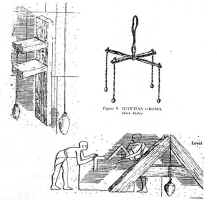|
 Article taken from "Backsights"
Magazine published by Surveyors Historical Society
Article taken from "Backsights"
Magazine published by Surveyors Historical Society
|
EGYPTIAN
SURVEYING TOOLS
by Mary M. Root
Four thousand years ago,
the concepts of math were basic, yet the Egyptians were able to achieve
wonders. They used the predecessors of modern surveying instruments to
engineer many feats, from canals to pyramids. An ancient Egyptian survey
crew used measuring ropes, plumb bobs, sighting instruments, and leveling
instruments.
The ancient Egyptian
measuring rope (the old term for "surveyors" was "harpedonaptae"
or rope-stretchers) was treated to hold its length. It was stretched taut
between stakes and then rubbed with a mixture of beeswax and resin. Some
of the ropes depicted in hieroglyph were graduated by knots tied at
intervals. Accuracy was creditable, according to a 1909 triangulation
survey that tied some original boundary stones. The Egyptian crews set the
stones to divide the fertile Nile delta, and the "rope" was
indispensable for measuring the distances.
 Plumb bobs were
appreciated for their ability to furnish a true vertical line. The
Egyptians employed plumb tools in their sighting and leveling instruments, and
as a way to continue distances vertically. They exploited all the
possibilities of the bob, using it for astronomy, navigation, surveying, and
building. It was their "workhorse" tool. Plumb bobs were
appreciated for their ability to furnish a true vertical line. The
Egyptians employed plumb tools in their sighting and leveling instruments, and
as a way to continue distances vertically. They exploited all the
possibilities of the bob, using it for astronomy, navigation, surveying, and
building. It was their "workhorse" tool.
The sighting instruments
were the "merchet" and the "groma". The merchet was a
staff with a wide notched top. The notch was a long slit through which the
instrument operator aligned a fixed plumb-line and the
"rope-men". This enabled them to measure long lines
effectively. The groma was a right-angle device designed for laying out
fields, much like the surveyor's cross of more recent times. Of the two,
the merchet was more accurate, and it was probably used to survey the pyramids.
Though nothing is known of
the long-distance leveling devices, two different short-distance types were used
to build the pyramids. The first was a water level. The bedrock was
networked with narrow trenches, then filled with water. The waterline was
marked on all the trench walls, the protrusions cut down, and the trenches
re-filled with stone to create a level base. The second type of level was
an A-frame with a plumb bob suspended from the apex. Since the Egyptians
understood the isosceles triangle, stones could be cut and chiseled square, and
mortared into place using this instrument.
Research continues to turn
up new evidence of surveying in ancient Egypt. There are but a few papyri,
hierglyphi, and actual artifacts documenting the surveyors and builders of their
world. But to appreciate the symmetry of the Cheops pyramid, and to note
that its north/south axis is only 03' 06" to the west of true north, means
to today's surveyor that the Pharaoh wasn't wasting his money on his surveying
bills. The surveyor's tools of the trade had come through.
|
